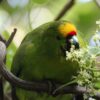Chatham Parakeet
Also known as:
Forbes' Parakeet
Also known as:
Forbes' Parakeet
DID YOU KNOW?
The Chatham Parakeet will readily forage on the ground on predator-free islands. It stays in the trees elsewhere.

Cyanoramphus

forbesi
Size:
23 cm (9 in)
Weight:
95 g (3.3 oz)
Subspecies including nominate:
one
Colour Adult:
Both adults bright green sides of face, red frontal band not reaching to eye, green/blue outer webs of flight feathers. Beak silver/black.
Colour Juvenile:
Not recorded.
Call:
High-pitched and weaker, but similar to, Red-fronted Parakeet (Cyanoramphus novaezelandiae). Repetitive ki-ki-ki-ki-ki.
More Information:
Content Sources:
CITES
Birdlife International
Cornell Lab of Ornithology/Birds of the World
A Guide to Parrots of the World, Juniper and Parr, 1998.
Vanished and Vanishing Parrots, Forshaw, 2017.
Lexicon of Parrots, Thomas Arndt.
Parrots of the World, Forshaw, 2006. 2010 edition
Captive Status:
Unknown.
Longevity:
Probably as in C. auriceps: 10 yrs.
Housing:
Probably as in C. auriceps: Walk-in enclosure, minimum length 3 m (9.8 ft).
Diet:
Probably as in C. auriceps: Small seed mix such as: millet, canary, and smaller amounts of oats, buckwheat, safflower and a little hemp; limited sunflower seed; spray millet; green leaves such as: Swiss chard, lettuce, kale, dandelion, sowthistle, chickweed; seeding grasses; rearing food made from: hardboiled egg, wholegrain bread and carrot, all ground to crumbly consistency; fruit may be offered; complete kibble.
Enrichment:
Probably as in C. auriceps: Provide seeding grasses for foraging; also bird-safe, unsprayed flowering, pine, fir, willow and elder branches. Provide shallow water bowls or overhead misters for bathing.
Nest Box Size:
Probably as in C. auriceps: Vertical box 8″ x 8″ x 14″ (20.3 cm x 20.3 cm x 35.5 cm).
Clutch Size:
Probably as in C. auriceps: 5-10
Fledging Age:
Probably as in C. auriceps: 5-6 weeks
Hatch Weight:
—
Peak Weight:
—
Weaning Weight:
—
World Population:
800-1000
IUCN Red List Status:
Vulnerable
CITES Listing:
Appendix I
Threat Summary:
The species disappeared from Mangere Island at the beginning of the 20th century due to a combination of deforestation for farming, decades of burning, the effects of introduced grazing mammals and predation by feral cats. The threat of predation by feral mammals remains, and hybridisation with C. n. chathamensis is a concern. The wild population is beginning to recover thanks to predator control and habitat management.
Range:
Restricted to Little Mangere and Mangere Islands in the Chatham Island group, New Zealand.
Habitat:
Confined to remnant tracts of native vegetation with a preference for mixed, unbroken Nothofagus-Podocarpus forest.
Wild Diet:
Consists of vegetable matter including leaves, buds, flowers and seeds, plus invertebrates such as caterpillars and scale insects.
Ecology and Behaviour:
Occurs in mixed flocks with Red-fronted Parakeets (Cyanoramphus novaezelandiae), found usually in mid-to-upper canopy. Will forage on the ground on predator-free islands, but wary when doing so. Birds nest in natural crevices or hollows in dead or living trees, or burrows in the ground.
Clutch and Egg Size:
5-9, 25.4 x 21.6 mm.
Breeding Season:
October-March; nest is in hollow limbs or trunks, often dead or decaying stumps.


![© Markanderson72 [CC BY-SA 4.0] via Wikimedia Commons A wild Chatham Parakeet forages in ground vegetation](https://gt2024.parrots.org/wp-content/uploads/2023/01/wpt_Chatham-Parakeet_1556-1-e1731536606890-100x100.jpg)
